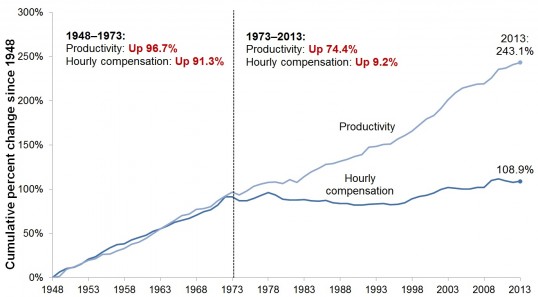
A series of recent reports from the Economic Policy Institute (EPI) make clear the case for why wages have stagnated in the United States.
Before digging into the details, it's important to note a few things. First off, wage stagnation is not a small problem, it's something that affects 90% of all workers. As one of the authors of these reports, Lawrence Mishel, says: "Since the late 1970s, wages for the bottom 70 percent of earners have been essentially stagnant, and between 2009 and 2013, real wages fell for the entire bottom 90 percent of the wage distribution." Second, while the Great Recession made things worse, the problem goes back 35 years. And third, and most importantly, wage stagnation is a matter of choice, not necessity.
Here are five real reasons why wages have stagnated in the United States.
1. The abandonment of full employment: For a variety of reasons, policy makers largely have focused on keeping inflation rates low, even if that meant high unemployment. A large pool of unemployed workers means companies are under less pressure to offer good wages or benefits in order to attract workers. Since the Great Recession, austerity measures at all levels of government have made this problem worse. EPI says excessive unemployment "has been a key cause of wage inequality, since research shows that high rates of unemployment dampen wage growth more for workers at the bottom of the wage ladder than at the middle, and more at the middle than at the top."
2. Declining union density: As extreme pro-business interests have pushed policies that lower union membership, the wages of low- and middle-wage workers have stagnated. Higher unionization leads to higher wages, and the decrease in unionization has led to the opposite effect. The decline in the density of workers covered by collective bargaining agreements not only has weakened the ability of unionized workers to fight for their own wages and benefits, but also their ability to set higher standards for nonunion workers. EPI notes: "The decline of unions can explain about a third of the entire growth of wage inequality among men and around a fifth of the growth among women from 1973 to 2007." Read much more about the connection between the decline of collective bargaining and wage stagnation.
3. Changes in labor market policies and business practices: EPI argues: "A range of changes in what we call labor market policies and business practices have weakened wage growth in recent decades." Among the numerous changes they describe include: the lowering of the inflation-adjusted value of the federal minimum wage, the decrease in overtime eligibility for workers, increasing wage theft (particularly affecting immigrant workers), misclassification of workers as independent contractors, and declining budgets and staff for government agencies that enforce labor standards.
4. Deregulation of the finance industry and the unleashing of CEOs: The deregulation of finance has contributed to lower wages in several ways, including the shifting of compensation toward the upper end of the spectrum, the use of the financial sector’s political power to favor low inflation over low unemployment as a policy goal, and the deregulation of international capital flows, which has kept policy makers from addressing imbalances, such as the U.S. trade deficit. EPI adds: "Falling top tax rates, preferential tax treatment of stock options and bonuses, failures in corporate governance, and the deregulation of finance all combined to increase the incentive and the ability of well-placed economic actors to claim larger incomes over the past generation."
5. Globalization policies: Decades spent in pursuit of policies that prioritized corporate interests over worker interests led to lowering of wages for middle- and lower-income workers in the United States. EPI concludes: "International trade has been a clear factor suppressing wages in the middle of the wage structure while providing a mild boost to the top, particularly since 1995."
EPI has also provided nine charts that lay out the picture of U.S. wage stagnation very clearly.

